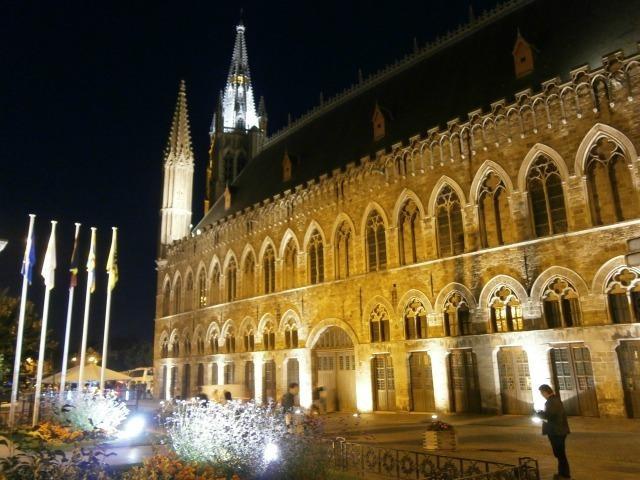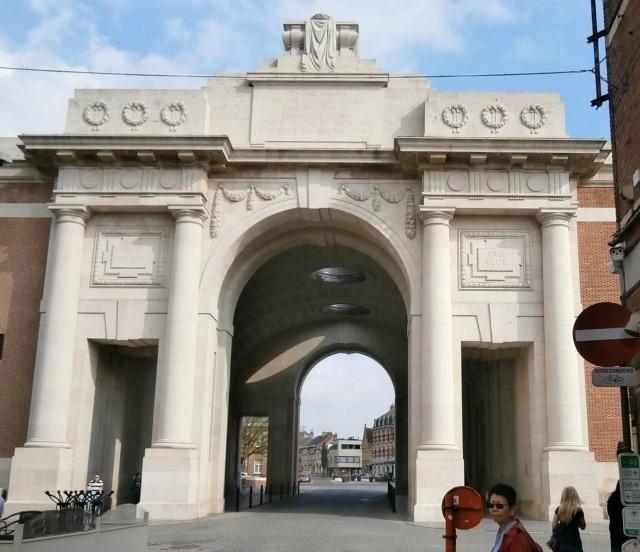Exploring Ypres, Belgium where poppies grow
It was eight in the evening. My husband Alex and I were huddled, together with a big crowd, under the massive stone arches of the Menin Gate in Ypres, Belgium, for the “Last Post.”
Suddenly, a hush descended upon us, and four uniformed soldiers came marching into the center, bugles in hand. The emcee read from a prepared text, in English, German, and French, solemnly exhorting us to remember, “Lest we forget!” After this the four soldiers lifted the bugles to their lips and sad notes were heard. It was a solemn salute to the fallen soldiers.
Ypres is a town in the Flanders area, in northwestern Belgium. During the First World War, it was in the strategic path of Germany’s plan to invade France from the north. Ypres had suffered much as the town defended itself, and the country, against this invasion. The Belgian contingent was joined by English, French, Australian, and New Zealand forces, and the town was practically razed after the First World War.
During the Middle Ages, Ypres (or, in Belgian, Ieper) was well-known for its textile industry, exporting their cloth and tapestries to as far as Russia and England. The cloth merchants were rich, and they constructed a huge and elaborate Cloth Hall at the center of town to keep their wares.

I learned about Ypres as we were looking for the Flanders area that Major John McCrae, a Canadian military doctor and artillery commander during WWI, wrote about in his popular poem, “In Flanders’ Fields.” It has become a favorite poem, known by heart since high school when our literature teacher required us to know it by heart. It was to Ypres then, that we hied off, after reading the historical significance of the place.
We passed by a commemorative wall with many bouquets of flowers in front. Upon closer look, it had four soldiers in full regalia, each one representing a different regiment of the two world wars.
We reached the Grote Markt, or the Main Square, in front of an immense medieval-looking structure, its length taking up around three huge blocks. At the center was a tall belfry, and in the façade of the building was a sign, “In Flanders Fields Museum.”
We hastened inside, got our tickets, and were given a red poppy bracelet with electronic chips on them for the interactive portions of the museum. The red poppy is a bright red flower very common in Flanders, now used as a symbol of remembrance for those that suffered in the war.
Overall, the atmosphere inside the museum was somber, as all visitors came face to face with how it was to live with the cruelties of war. There were many exhibits, including heart-wrenching letters, unsent, retrieved from pockets of slain young soldiers written to their mothers; dog tags, notebooks, looped documentaries that told of the huge casualties of the First World War, the artilleries, the uniforms. Very evocative was the documentary of the Christmas Truce of 1914, where English and German soldiers came out of their trenches, exchanged cigarettes and food, told stories, and even sang Christmas songs together. Everyone was homesick, and tired of the war.
Coming out of the museum into full sunshine, we marveled at the reconstruction that was done, with the help of German reparation money. The locals were able to build an exact replica of the 13th century Cloth Hall, the belfry, and the nearby St. Michael’s Cathedral with a higher spire, visible from afar.
We continued to walk towards the Vauban ramparts, built as early as the 17th century by King Louis XIV’s military engineer, the Marquis de Vauban. It was a quiet leafy walk, our shoes crunching on the paths strewn with yellow fallen leaves.
We reached the Lille Gate, and entered the Ramparts’ Cemetery. Rows upon rows of white markers stood silently; nearby, graceful strands of weeping willows reached down to touch the waters of a quiet lake, its surface rippled by a cool breeze. This was one of the cemeteries for English soldiers who were buried in Ypres. The tranquility was soothing, as birds flitted here and there, with their songs.

We wound our way back to the town, and visited the St. George Memorial Church, consecrated in 1929, to commemorate the more than 500,000 English and Commonwealth soldiers who died in the battles in Ypres. Nearby was another war cemetery, the Reservoir Cemetery. The land of both Rampart and Reservoir Cemeteries were gifts by the Belgian people to Great Britain, in gratitude for the latter’s defense during the First World War.
Suddenly feeling hungry, we came upon the Pizzeria Babilonia, a cozy-looking restaurant with smiling servers. A Pizza Margherita and Pasta Arrabiata with lemonade and beer were enjoyed, as we waited for the “Last Post” at the Menin Gate.

The Menin Gate is a huge concrete arc, a memorial for missing soldiers belonging to the Great Britain and its Commonwealth Nations (except Newfoundland and New Zealand). About 54,000 names were inscribed on its walls from floor to ceiling, and red poppy bouquets filled the stairs by the arc’s sides, with names of military regiments inscribed on the walls.
The “Last Post” is a ceremony that began in 1928 to remember the war dead. Members of the fire brigade blew their bugles at exactly eight in the evening, whether it was a fine night, raining, snowing or even in the direst of weathers. Villagers often set their watches by the “Last Post” bugles. No nights were missed, except during the German occupation of Ypres, when it was prohibited.
The rites were very solemn, and the hairs on my nape stood on end as the bugle notes pierced the night with their plaintive song.
Afterwards, we joined the crowd that flowed towards the Grote Markt, seduced by the lighted façade of the museum and the fountains, making them look like glowing lanterns; as John McCrae’s poem continued to echo in our minds: “…and if ye break faith with us who die/ We shall not sleep/ though poppies grow/ in Flanders Fields.” —KG, GMA News



